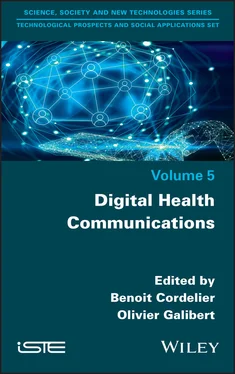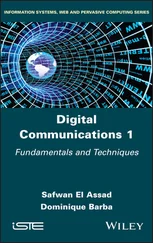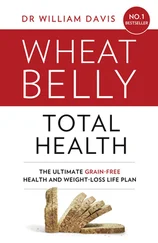Digital Health Communications
Здесь есть возможность читать онлайн «Digital Health Communications» — ознакомительный отрывок электронной книги совершенно бесплатно, а после прочтения отрывка купить полную версию. В некоторых случаях можно слушать аудио, скачать через торрент в формате fb2 и присутствует краткое содержание. Жанр: unrecognised, на английском языке. Описание произведения, (предисловие) а так же отзывы посетителей доступны на портале библиотеки ЛибКат.
- Название:Digital Health Communications
- Автор:
- Жанр:
- Год:неизвестен
- ISBN:нет данных
- Рейтинг книги:3 / 5. Голосов: 1
-
Избранное:Добавить в избранное
- Отзывы:
-
Ваша оценка:
- 60
- 1
- 2
- 3
- 4
- 5
Digital Health Communications: краткое содержание, описание и аннотация
Предлагаем к чтению аннотацию, описание, краткое содержание или предисловие (зависит от того, что написал сам автор книги «Digital Health Communications»). Если вы не нашли необходимую информацию о книге — напишите в комментариях, мы постараемся отыскать её.
Digital Health Communications — читать онлайн ознакомительный отрывок
Ниже представлен текст книги, разбитый по страницам. Система сохранения места последней прочитанной страницы, позволяет с удобством читать онлайн бесплатно книгу «Digital Health Communications», без необходимости каждый раз заново искать на чём Вы остановились. Поставьте закладку, и сможете в любой момент перейти на страницу, на которой закончили чтение.
Интервал:
Закладка:
An important part of the digital health communication work carried out in ICS is questioning online public communication. In a dominant paradigm of promoting health democracy and the empowerment of a patient who must become an actor in his or her care, the research conducted here attempts to analyze the different communication strategies orchestrated by public authorities towards the general public. The Internet then feeds the imagination of a recomposed public space in which the patient and his or her caregivers ideally participate in the public health debate and dedicated political decisions. Paradoxically enough, this research shows that the logic of a persuasive public advertising communication, in which the patient is a target to be convinced, is resistant to disappear in favor of a more “collaborative” approach, which is nevertheless desired. In a perspective marked by health promotion, despite the objective of going beyond “traditional” communication strategies, public authorities often consider that
“the other” is not an enigma to be deciphered or discovered, but a stranger who must be convinced so that he will modify or change his attitude. [REN 07]
The same applies to the work of the ComSanté team, which is continuing and diversifying this approach [KIV 09]. This research resonates with other works that highlight attempts at the dialogical adaptation of health institutions, particularly in the face of health crises. In the context of the massification of SICDs specific to the collaborative Web, the controversies arising from these crises are deployed in digital public debate arenas in which the biomedical voice is challenged [OLL 15], or at least discussed, either by Internet users with no particular knowledge of the disease other than experiential knowledge, or by citizens who want to make their voices heard, often critical and discordant, on crisis management.
Digital public health communication continues to be in tension between the strategies of institutional, political and industrial actors and the more informative and community-based logics aimed at emancipating all citizens through knowledge and reasoned and reasonable discussion. Public authorities are forced to completely review their communication policies, giving priority to participatory mechanisms in order to play an active role in a health public space [PAI 07], which must nevertheless be controlled. It is therefore a question for ICS researchers to understand the new modalities of a strategic communication called 2.0 which, under the guise of a health democracy aiming at the participation of all in the improvement of health care, would seek to better orient exchanges in a logic oscillating between political communication and therapeutic education [ROM 10].
The patient-actor becomes the pivot of this new info-communicational strategy. No longer just a passive receiver of public health info-communication campaigns, the patient uses SICDs to participate in the improvement of care, or even to co-create therapeutic innovation. This is how very recent research is studying how the patient is projected at the heart of the creation of e-health solutions [BON 19]. The perspective is perfectly summarized by Marc Lemire. For the Canadian researcher, the use of the Internet immediately implies a proactive approach on the part of the patient. For Lemire,
this attitude differs from passive obedience, an attitude usually attributed to the patient and generally expected in “classic” models of healthcare management. This is the case with the professional model of compliance, which remains widespread in modern healthcare systems. [LEM 09]
However, not all citizens, potential users of health care, are equally equipped to deal with a digital divide that may, in the long term, create real health information disparities. Indeed, as Joëlle Kivits and Sophie Gendarme point out, access to health information no longer seems to be an economic or technological issue, but a question of health literacy, that is, the ability to
understand media content (Rootman, Gordon-El-Bihbety, 2008), an ability that is more important for people with higher levels of education. In this sense, it is a marker of inequality in terms of Internet use, and more generally in terms of health. [KIV 15]
P.6. Digital health communication: the promise of cognitive, social and emotional support
The massification of digital tools is therefore profoundly modifying the informational and communicational practices of patients and their caregivers. These practices seem to be deeply emotional, on the one hand, because of the need to be informed about our pathology or that of a loved one, to better understand the treatment and its side effects, and to grasp the issues at stake in terms of duration or hospital/outpatient care and, on the other hand, because of the need to share our experience and benefit from that of others in the face of a disease.
Work on online patient information modalities is still relevant, systematically reactivating the analysis of tensions and struggles for recognition between knowledge from the experience of care and knowledge from scientific and academic institutions. This is how Viviane Clavier highlights a form of unpreparedness on the part of healthcare professionals in the face of general questions related to current events asked by patients, which lead the specialist into non-specific answers for which she or he will have a form of natural distrust [CLA 19]. This is why health information is consulted, discussed, shared and produced by patients who are concerned about better understanding of the disease, its treatment and, above all, how daily life will be organized around it in the future. Marc Lemire encourages the academic community to consider with great interest this “heterodox knowledge” that resonates or competes with “biomedical knowledge” [LEM 09]. So-called lay knowledge, although it can compete with institutionalized biomedical hegemony in the context of a rebalanced patient–professional care relationship [ACK 10], nonetheless remains a fully-fledged informational and emotional resource for patients. As noted by Pierre Mignot and Dorsaf Omrane in their study of a digital breast cancer prevention dispositive, it is necessary to underline “the persuasive power of ‘knowledge from experience’ in the spaces of online exchanges between the people concerned” [MIG 18].
This new form of experiential expertise [PAG 14] constitutes, at a time when the expert patient is becoming a professional, a central subject of study that we will find in Chapters 7and 8of this book. This new cognitive and informational situation is also coupled with a significant social and emotional contribution. If the patient’s presence online is motivated by the need to be informed, it is also an opportunity to forge links with other patients who share a similar reality. This is how online social and emotional support [CHE 19] constitutes the other side of a digital community link whose social logic has yet to be widely explored in the health sector.
P.7. And finally, how can we take care of digital workers?
To conclude this overview of digital communication in health from the point of view of ICS, we would like to reiterate that the digital is itself considered a major health issue, especially at work [BOU 15a]. The idea here could be similar to the perspectives opened up by Bernard Stiegler in his pharmacology of the digital world [STI 06], where online practices are both a remedy for many informational and relational deficiencies, as well as a social poison. The aim here is to understand the psycho-sociological risks linked in particular to what we could define as “connective burn-out”. Some researchers in the field therefore favor the term techno-sociological risks (TSR) such as
Читать дальшеИнтервал:
Закладка:
Похожие книги на «Digital Health Communications»
Представляем Вашему вниманию похожие книги на «Digital Health Communications» списком для выбора. Мы отобрали схожую по названию и смыслу литературу в надежде предоставить читателям больше вариантов отыскать новые, интересные, ещё непрочитанные произведения.
Обсуждение, отзывы о книге «Digital Health Communications» и просто собственные мнения читателей. Оставьте ваши комментарии, напишите, что Вы думаете о произведении, его смысле или главных героях. Укажите что конкретно понравилось, а что нет, и почему Вы так считаете.












